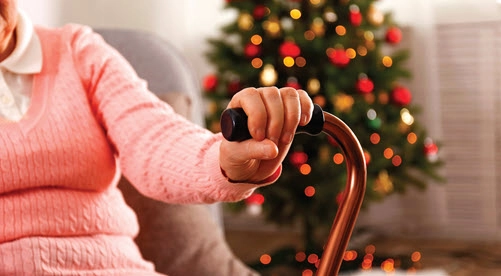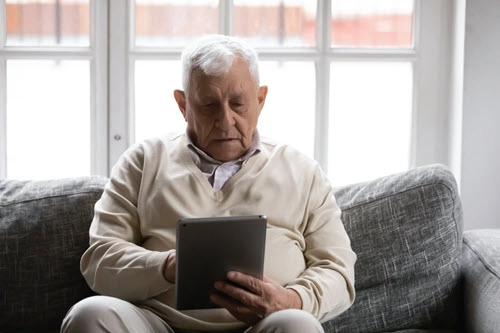Facilitate Safe Holiday Celebrations
Keeping residents safe, but not socially isolated, over the holidays is more important than ever. To keep everyone as safe as possible, organizations should strongly discourage residents leaving the facility for holiday celebrations or any other unnecessary reason, says the Centers for Medicare & Medicaid Services (CMS) in a special alert for nursing homes, residents, and resident representatives. “We encourage residents to discuss these and other risks with their families and nursing home staff. Nursing homes should educate residents and families of the risks of leaving the facility, the steps they should take to reduce the risk of contracting COVID19, and encourage residents to stay connected with loved ones through alternative means of communication, such as phone and video communication,” says Seema Verma, CMS administrator, in the Nov. 18, 2020, alert. Try for Virtual, First As SARS-CoV-2, the virus that causes COVID-19 infection, spreads at unprecedented levels across much of the country, leaders at most levels of government and public health officials are either regulating gatherings or mandating various transmission-mitigation protocols, a lot of which falls on individuals to uphold. The holidays are a particularly sore point: After such a hard year, many folks would like nothing more than to finally spend time with loved ones in person. Both infectious disease experts and elected officials warn that finally spending time with loved ones in person, especially the elderly, could very well translate to seeing them for the final time. Consequently, the strong recommendation for virtual visiting still stands, and CMS, especially, is pushing for residents to rely on technology and stay safe, versus seeing family and risking infection. At this point, your facility should have both the equipment and the protocols in place to enable residents to connect virtually with their loved ones. However, if any residents are leaning toward leaving the facility to celebrate with loved ones, try to illuminate the risk, CMS says. The numbers are stark: According to data compiled and analyzed by The New York Times, at least 94,000 deaths of residents or staff have been attributed to COVID-19. The virus has infected more than 662,000 people at 26,000 facilities across the country, their analysis shows. At least half of 14 states’ total deaths are linked directly to long-term care facilities. The introduction or presence of COVID-19 in a nursing facility is not a reflection of that facility’s infection control measures or other efforts; it is a consequence of community spread (See “Understand How COVID-19 Affects Communities, Facilities” in MDS Alert Vol. 18, No. 8). Still, to reduce risk as much as possible, facilities should still do everything they can to help residents feel safe, secure, and happy as possible spending the holidays at the facility. CMS did not offer additional guidance on holiday dinners in the facility, such as whether it was safe to resume dining room meals for special occasions, beyond recommending finding “innovative ways of celebrating the holidays without having parties or gatherings that could increase the risk of COVID-19 transmission (e.g., virtual parties or visits, provide seasonal music, movies, decorations, etc.).” Enforce These Precautions CMS upholds residents’ individual rights, and therefore urges facilities to have protocols in place to explain the risks of infection of COVID-19, and build in screening protocols upon residents’ return, if anyone chooses to leave. “While CMS supports family engagement and a resident’s right to leave the nursing home, everyone needs to work together to take extra precautions to help reduce the spread of COVID-19, which can pose an elevated danger to the health of nursing home residents,” Verma says. The precautions that CMS and the Centers for Disease Control and Prevention (CDC) recommend are the same that both agencies have recommended for months now: physically distance, avoid large gatherings, wear a mask at all times except when eating or drinking, meet outdoors if possible, and perform hand hygiene, among other guidance. CMS points out that this holiday-specific guidance should be followed by residents who choose to leave — as well as staff when they aren’t at work. Cement your screening protocols for any individual’s return. CMS suggests screening for symptoms and increasing monitoring of those respective residents and testing for COVID-19 if the resident shows signs or symptoms or a family member has reported potential exposure. CMS also notes that facilities “may opt” to test asymptomatic residents if their families report potential exposure or the resident has been away from the facility for over 24 hours. Utilize transmission-based precautions (TBP) if the resident’s family reports possible exposure, the resident shows signs or symptoms, or the resident was away from the nursing home for more than 24 hours. Don’t Forget the Care Plan If staff know that a resident is considering leaving, incorporate that knowledge into the resident’s care plan. “If it is known the resident wants to leave, I would suggest care planning that it’s known — and include education provided to both the resident and their family,” says Jane Belt, MS, RN, QCP, RAC-MT, RAC-MTA, curriculum development specialist at American Association of Post-Acute Care Nursing (AAPACN) in Denver. Make sure you cover as many bases as possible. Belt recommends considering these questions: “Are written protocols given to the resident and family? What should happen if the resident starts to show symptoms of COVID when with the family — does the family know what to do?” Review the symptoms of COVID with the resident and the family, too. “Document that not only in the care plan but in the medical record — you can write anything on the care plan, but the documentation is going to prove that the actions were taken,” Belt says.


